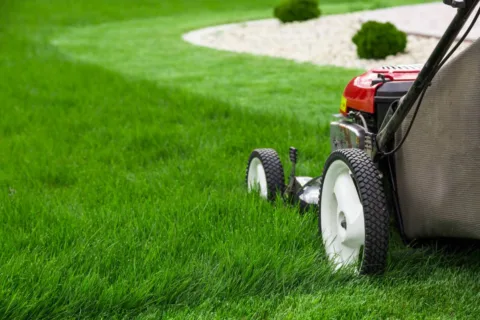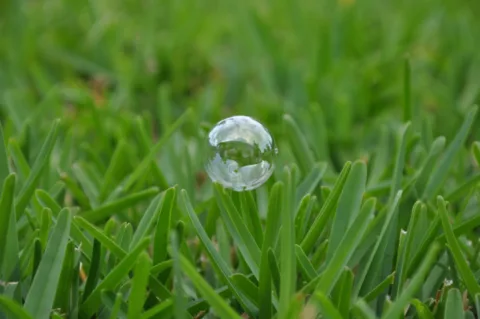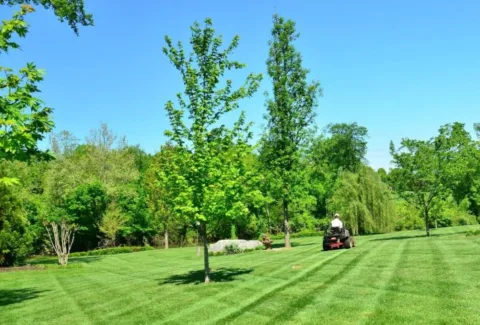Ever hear of Floratam grass? If you live anywhere in the Southeast, it’s likely that you or at least one of your neighbors have Floratam growing in the yard.
It’s been growing in the yards of several Florida homes I’ve lived in since the 1980s — and I, for one, have enjoyed the appearance and easy maintenance of Floratam grass!
Floratam isn’t the “perfect” grass — it has both pros and cons — but it’s a gorgeous grass that looks good and grows well in millions of landscapes throughout the Southeast.
So, what is Floratam? Is it the right type of grass for your yard? Let’s dig in together and get to the root of Floratam grass!
Floratam Grass 101
Floratam is a very distinctive kind of grass with thick, bluish-green blades that grow on creepers called stolons — which produce a thick, hardy, lush-looking lawn.
It can be planted by sod, sprig, or plug and is ideal for sunny locations that receive at least 6 hours of sun.
If you’ve seen Floratam before, it probably reminds you of the popular St. Augustine grass — which at quick glance looks like Floratam.
In fact, scientists at the University of Florida and Texas A&M University developed Floratam in the early 1970s as a cultivar that’s more pest-resistant than St. Augustine. Floratam was also developed to resist St. Augustine Decline (or “SAD”).
Over time, Floratam has become less resistant to increasingly stronger varieties of chinch bugs — which are the bane of any landscaper who loves St. Augustine grass. I can attest to the fact that I have, indeed, dealt with more insects damaging my Floratam grass in recent years.
You’ll likely also be disappointed to find out that I’m seeing just as many fire ant mounds in Floratam yards as in St. Augustine and other types of Florida grasses.
Still, Floratam remains popular because it’s drought tolerant, has thick blades, grows vigorously in hot climates, and its thick growth helps to choke out weeds.
Other Unique Characteristics Of Floratam
- In the right conditions, Floratam grass can grow as much as 3/4″ across the ground in a single day! That means a bare yard studded with Floratam grass plugs may appear lightly covered in only a month or so. (Sure, you can use can Floratam sod on your property and get an “instant yard” — but that’s a lot more expensive than plugging your yard.)
- Floratam blades are thick — the grass blades are generally wider and longer than St. Augustine blades of grass.
- In addition to its blue-green blades, Floratam grass has purple-colored stolons (those creepers, remember?)
- Floratam is really best for open yard spaces with full sun — not under trees, near house overhangs, or other areas where very little sun reaches the ground.
How To Care For Floratam Grass
Floratam isn’t very difficult to care for when it’s planted in the right location. But keeping a nice-looking landscape requires a bit of work.
The following tips will help you take really good care of your Floratam yard…
Tips For Mowing Floratam Grass:
- It’s ideal to mow Floratam at a height of 3″ to 4″ — the higher the better.
- Many lawn experts will suggest you mow Floratam as high as the rotary blade goes on your mower. This allows the grass to grow nice and thick — helping to prevent weed growth and allowing the roots to grow deep enough to improve its drought tolerance.
- Just sodded your yard with Floratam? Wait to mow until at least 2 weeks after it was planted, or until the time the growing roots won’t let you pick up your Floratam sod from the dirt.
Tips For Watering Floratam:
- If you’re planting new Floratam sod, it needs to be watered at least once or twice per day for the first couple weeks — even longer, in some instances.
- After Floratam grass is established, it needs about 1″ of water each week. What’s really important is that the watering is a good, even soaking. So, it’s better to give the grass a nice thorough watering for 30 to 45 minutes at a time than to spritz it throughout the week for only 5 or 10 minutes each time.
- If the blades are wilting, it’s time to water your Floratam grass! (Of course, you should always follow your local community watering guidelines.)
Tips For Fertilizing Floratam Grass:
- Floratam loves water-soluble fertilizer with the ratios of 3 parts nitrogen (N), 1 part phosphorus (P), and 2 parts potassium (K) — which is 3-1-2. Or, 4N-1P-2K — which is 4-1-2. Water-soluble fertilizer granules work well — just spread it with a standard broadcast spreader for a good, even coverage.
- It’s best to apply fertilizer once a month during the first 3 months after your Floratam begins growing in the spring, and then continue fertilizing every 30 to 60 days into the late fall.
My Personal Experience Maintaining A Floratam Yard

Floratam doesn’t like high-traffic areas. It’s prone to turning brown and dying when walked on too much. (The same is true for St. Augustine grass, by the way.)
That’s why I stopped putting Floratam in areas of the yard where my family and I are likely to cut through — such as those corners near pathways that turn at right angles (because we always just take a shortcut across the grass).
And it’s true what they say — the higher you cut your Floratam, the better it will grow! I’ve cut it a little shorter than I should have at times, and the grass always started thinning out when I did this. Plus, that’s when the weeds begin coming in.
Speaking of mowing, be sure your mower blades are sharp. Floratam is coarse and requires a really good, sharp blade for even cutting and minimal shredding or tearing of the leaf tips — which can harm or even kill the grass.
I really can’t overstate how poorly Floratam grows in the shade. I’ve tried multiple times to get it growing in areas that receive only partial shade in the afternoon, and it always dies in those locations.
However, I know some neighbors who have gotten their Floratam to grow relatively well in filtered shade (especially under oak trees and pine) — so it might be worth experimenting to see how well it grows in your yard. Perhaps buy plugs first to test the tolerance of Floratam grass in certain areas of your yard before investing in a full Floratam sod job.
For shady areas, I suggest finding more shade-tolerant cultivars — such as St. Augustine or another type of grass.
Is Floratam Right For Your Yard?
Floratam is a hot-weather grass.
Here in Florida, where Floratam is the most popular grass cultivar, it:
- Looks great pretty much year-round in Miami
- Stays green most of the year in my neck of the woods near Tampa until dormancy in the winter
- Is absolutely seasonal in North Florida — it goes dormant from late fall through early spring there
It’s also a popular grass in Texas, and most especially the southeastern regions of Texas.
Floratam is also grown in other parts of the Southeast.
Officially speaking, Floratam is ideal for USDA Hardiness Zones 8 through 10 — which includes the following areas of the United States:
- All of Florida
- The southern regions of Georgia, Alabama, Mississippi, and Texas
- Most of Louisiana
- Coastal South Carolina, North Carolina, and Virginia
- Some areas of coastal Southern California
- Hawaii
The Bottom Line…
If you live in a warm-weather climate and want a lush yard that’s resistant against a variety of common grass pests, will thrive in many kinds of soil, and can withstand dry periods, then Floratam grass might be the perfect solution for your lawn.
It certainly has been for mine!
More Info On Floratam
In addition to the links I’ve included above, here are some other resources to help you decide if Floratam grass is right for you:
- What Is The Difference Between St. Augustine And Floratam Grass?
- How To Get Rid Of Chinch Bugs
- Dealing With SAD In St. Augustine Grass
- How To Deal With Weeds In Floratam Grass
I’m a roller coaster junkie, a weather enthusiast, a frequent traveler, and a numismatist. My love for coins began when I was 11 years old. I primarily collect and study U.S. coins produced during the 20th century. I’m a member of the American Numismatic Association (ANA) and the Numismatic Literary Guild (NLG). I’ve also been studying meteorology and watching weather patterns for years. I enjoy sharing little-known facts and fun stuff about coins, weather, travel, health, food, and living green… on a budget. I work from home full-time as a journalist, reporter, and author.









